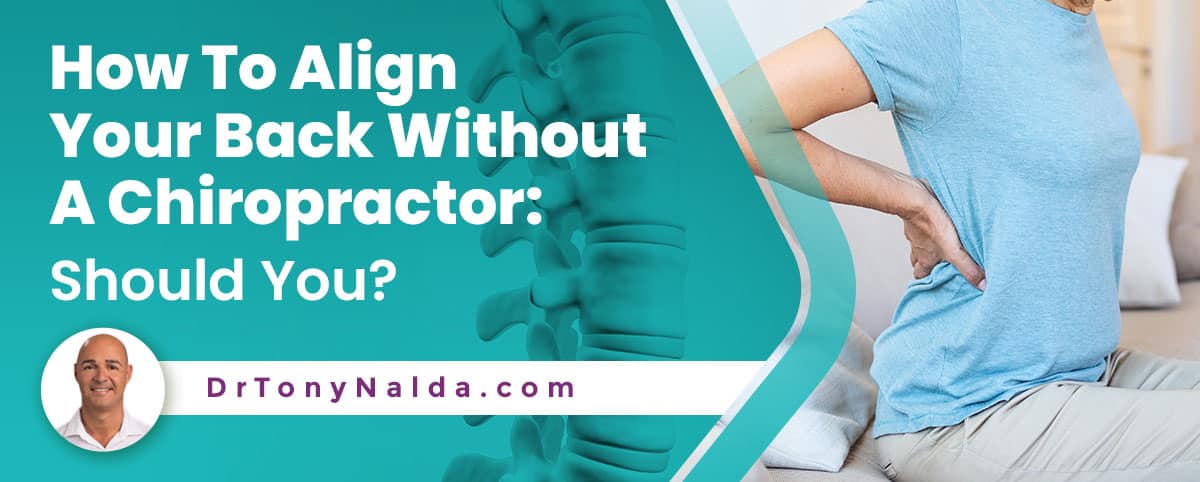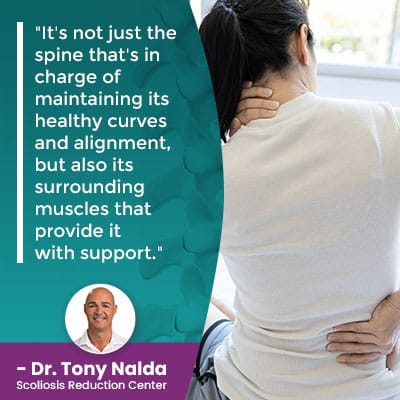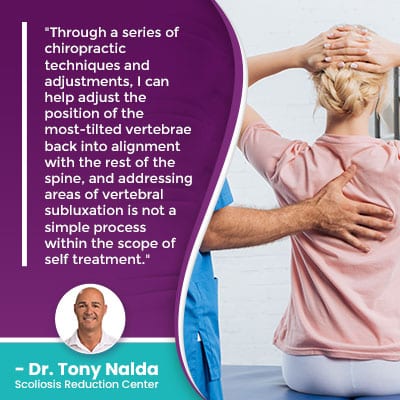How To Align Your Back Without A Chiropractor: Should You?

The design of the spine is based on movement, and the spine's optimal function depends on its ability to maintain its natural and healthy curves. When the spine's curves are in place as they should be, its vertebrae are stacked on top of one another in a straight and neutral alignment. If the spine becomes misaligned due to a structural issue, this requires condition-specific care and should not be attempted without the guidance of a professional.
When the back is misaligned due to scoliosis, this is a structural spinal condition that necessitates a customized treatment approach. While certain home exercises and practices can promote a healthy spinal alignment, structural spinal conditions need a multifaceted treatment approach crafted by a specialist.
The vertebrae of the spine give it structure and combine forces to facilitate strength and flexibility, so let 's start with some basic spinal anatomy.
Table of Contents
Anatomy of a Healthy Spine
A healthy spine has its natural curves in place, and the natural curves make it stronger, more flexible, and better able to absorb mechanical stress during activity.
In order for the spine to function optimally, the vertebrae have to be aligned, which means stacked on top of one another in a straight and neutral alignment.
The vertebrae are separated by an intervertebral disc, and these spinal structures are key to overall spine health; they give it structure, flexibility, act as the spine's shock absorbers, and provide cushioning between adjacent vertebrae.
If the spine's healthy curves are in place, its vertebrae are aligned as they should be, but if they are not, this means some of its vertebrae have shifted out of alignment with the rest of the spine, and this disrupts the spine's overall biomechanics.
People can practice a spine-friendly lifestyle to promote optimal spinal alignment with proper posture, strong core muscles, a healthy walking posture, good sleeping posture (sleeping with a flat pillow between the knees for side sleepers), finding a spine-friendly sleeping position, using a firm pillow, the use of an ergonomic office chair, getting chiropractic adjustments when needed and chiropractic care, avoiding improper sitting and unnatural neck tilts, and moving regularly for a healthy daily routine.
The spine's design is based on movement, so leading a sedentary lifestyle is not good for maintaining spinal health, strength, and flexibility.
The spine helps us to stand upright, practice good posture, move flexibly, and absorbs and distributes mechanical stress; in addition, the spinal cord within works in tandem with the brain to form the body's central nervous system.
So as you can see, a healthy spine is important and healthy spinal alignment is part of that; now, if a spinal misalignment is caused by a structural issue, that means there is a structural abnormality within the spine itself, and that is not a simple issue to address.
Scoliosis and Spinal Alignment
When a patient is diagnosed with scoliosis, this means their spine has developed an unnatural sideways spinal curvature that rotates, meaning it also twists, and this introduces a lot of uneven forces to the body.
Scoliosis is a structural spinal condition, of which there are many, and as an unnatural spinal curvature develops, the spine becomes misaligned because some of its vertebrae have become excessively tilted out of alignment with the rest of the spine.
 It's not just the spine that's in charge of maintaining its healthy curves and alignment, but also its surrounding muscles that provide it with support.
It's not just the spine that's in charge of maintaining its healthy curves and alignment, but also its surrounding muscles that provide it with support.
So a misaligned spine can also affect its surrounding muscles by pulling them in different directions and causing a muscle imbalance to develop; in scoliosis, the muscles on one side of the spine can become tight from overuse, while the muscles on the other side can become weak from underuse.
Trying to self correct a misaligned spine is not possible when it's a structural issue, and while practicing a spine-friendly lifestyle can help prevent a misaligned spine and promote spinal health, it can't correct a structural issue within the spine that reverses the affected vertebrae's unnatural tilt.
So should you attempt to align your back without a chiropractor? No, while practicing healthy posture and maintaining a healthy weight and activity level can help preserve a healthy spinal alignment, it can't reverse a structural issue once it's developed.
Scoliosis Treatment
Here at the Scoliosis Reduction Center, I treat spinal conditions with a conservative proactive chiropractic-centered treatment approach.
I work towards realigning the spine naturally so patients don't have to face the risks of needing invasive surgical treatment in the future.
As a complex 3-dimensional spinal condition (rotational component), scoliosis has to be impacted on a structural level, first and foremost, and this is worked towards through condition-specific chiropractic care.
 Through a series of chiropractic techniques and adjustments, I can help adjust the position of the most-tilted vertebrae back into alignment with the rest of the spine, and addressing areas of vertebral subluxation is not a simple process within the scope of self treatment.
Through a series of chiropractic techniques and adjustments, I can help adjust the position of the most-tilted vertebrae back into alignment with the rest of the spine, and addressing areas of vertebral subluxation is not a simple process within the scope of self treatment.
As a structural spinal condition, no one treatment discipline is enough to address its complexity, so I integrate multiple different treatment modalities so plans can be fully customized to address key patient/condition variables.
In addition to chiropractic care, condition-specific physical therapy is also a facet of my treatment approach; this can help strengthen the back muscles so the spine is naturally supported and blood flow in and around the back is increased, which also helps keep the spine's intervertebral discs healthy as they are the largest structures in the body without their own vascular supply.
A physical therapist can also help address any related muscle imbalance by strengthening the weak side, and taking pressure off the overused side.
Corrective bracing can also help augment corrective treatment results by pushing the spine into a corrective condition.
The final phase of treatment is an ongoing one: a home-rehabilitation program involving a series of custom-prescribed rotational exercises and scoliosis-specific exercises (SSEs) to further stabilize and heal the spine.
In addition, monitoring via X ray is the only way to really know what's happening in and around the spine, and part of my treatment involves monitoring how the spine is responding to growth and treatment, and apportioning treatment disciplines accordingly.
Unless a person has access to an X-ray machine at home, they can't properly monitor what is happening with their spine, and this is important, particularly with a progressive condition that has it in its nature to get worse over time: scoliosis.
Conclusion
I wholeheartedly support the drive to be proactive with one's own health by leading a healthy lifestyle as this can help prevent a number of health/spinal issues from developing, but what I don't support is attempting self treatment for conditions that require the skills of a specialist.
When a spine is misaligned, a natural curve is lost, and this can cause postural changes such as forward head posture, neck pain, rounded shoulders, uneven shoulder blades, radiating pain throughout the entire body due to nerve compression, one shoulder sitting higher than the other, and a variety of medical issues.
Seeking out treatment from a medical professional, better yet one that specializes in treating the spinal condition present, is essential, particularly with complex 3-dimensional structural spinal conditions like scoliosis.
Spine problems can be unpleasant and cause a variety of symptoms that can involve posture, muscle pain, back pain, and/or nerve pain.
In order to promote a healthy spinal alignment, be proactive by using a supportive pillow during sleep, sleeping on a comfortable and supportive firm mattress, understanding and practicing the ergonomics of heavy lifting with the legs, and making an active effort to maintain good posture and keep the spine straight.
In addition, maintaining a healthy weight means less pressure on the spinal joints, and this can reduce inflammation; staying active also means the spine and its surrounding muscles are kept as strong and flexible as possible.
Spinal mechanics are important for its overall spinal health, strength, and function, and when it comes to a structural misalignment of the spine, this requires treatment crafted and delivered by a specialist who can properly align the spine.
If a spine is misaligned, it also affects the pelvis area, an essential area/structure when it comes to maintaining good posture and an economical gait.
So while a person can most certainly be proactive with their spinal health by practicing a spine-friendly lifestyle that cares for their own back, if a scoliotic curve develops, its unnatural bend and twist is beyond the scope of self treatment.
Dr. Tony Nalda
DOCTOR OF CHIROPRACTIC
After receiving an undergraduate degree in psychology and his Doctorate of Chiropractic from Life University, Dr. Nalda settled in Celebration, Florida and proceeded to build one of Central Florida’s most successful chiropractic clinics.
His experience with patients suffering from scoliosis, and the confusion and frustration they faced, led him to seek a specialty in scoliosis care. In 2006 he completed his Intensive Care Certification from CLEAR Institute, a leading scoliosis educational and certification center.
About Dr. Tony Nalda
 Ready to explore scoliosis treatment? Contact Us Now
Ready to explore scoliosis treatment? Contact Us Now





